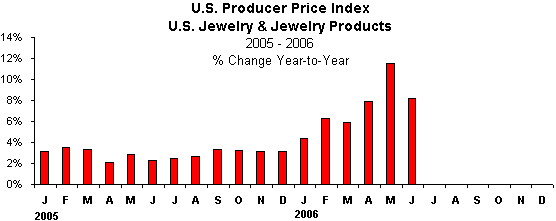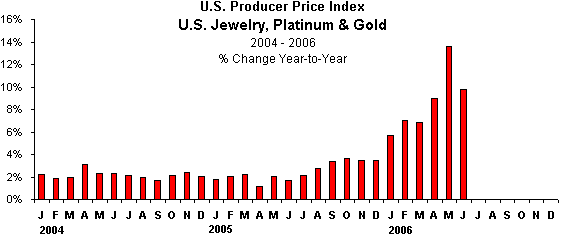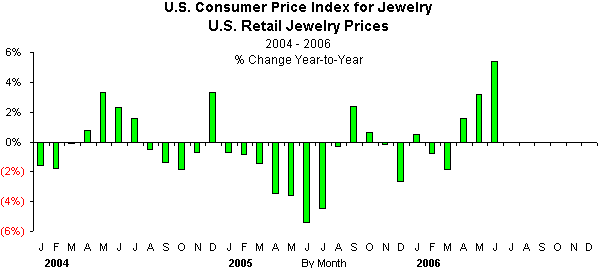IDEX Online Research: U.S. Jewelry Producer Prices Moderate, But Retail Jewelry Prices Climb
August 01, 06
The U.S. Jewelry Producer Price Index (JPPI) showed a smaller increase in June than in prior months, indicating that climbing commodity prices may have paused, at least for the moment. Producer prices for jewelry rose by 8.2 percent in June 2006 versus the same period last year. This represented a slowing from last month’s record 11.5 percent increase.
Meanwhile, retail prices for jewelry surged in June, reflecting the flow-through to retail of higher producer prices from prior months. Retail jewelry prices were up by 5.4 percent in June 2006 versus the same month a year ago. This was the largest gain in more than a decade.
Commodity Prices Continue to Rise, But at a More Modest Pace
Once again, U.S. Fed chairman Ben Bernanke apparently has called inflation trends correctly. When he testified before a Senate hearing just a few days ago, he indicated that the Fed felt that the inflation threat had been dampened. Clearly, this viewpoint was reflected in the JPPI which showed some moderation in growth during June.
For the month of June 2006, polished diamond prices rose by a very modest 2.5 percent, the smallest increase in the past twelve months. Since diamonds and diamond jewelry represent almost 50 percent (by value) of the U.S. jewelry market, the almost imperceptible gain in diamond prices helped rein in the growth of the JPPI during June.
The graph below summarizes monthly JPPI by month for 2005 and year-to-date 2006 through June.

Source: BLS
Precious Metals Price Gains Slow
The slowing growth of the JPPI also reflects the pull-back in the price of gold at the end of June. On June 30, 2006, gold closed at around $613 an ounce, well below levels in May when it traded day after day in the high $600s. Since then, gold prices have rebounded; this will put pressure on July’s JPPI.
Likewise, both silver and platinum prices pulled back at the end of June. This helped keep the JPPI from rising more rapidly during the month.
The graph below summarizes the Producer Price Index for Platinum and Gold Jewelry for the past three years. It tracks very closely with the “All Jewelry Producer Price Index” graph shown above.

Source: BLS
Retail Jewelry Prices Up Sharply
Retailers have finally gotten serious about raising the retail prices for their jewelry. In the vernacular, “no one wants to blink first.” By this, we mean that no one wants to be the first to raise retail prices. As a result, retailers’ margins have been sagging. Further, merchants have been putting pressure on their suppliers to hold prices.
However, after months of unrelenting increases in the JPPI, it was inevitable that these cost pressures would finally flow through to the end of the jewelry pipeline and affect retailers enough to cause them to raise prices.
The graph below summarizes the Jewelry Consumer Price Index (JCPI) since the beginning of 2004 through June 2006.

Source: BLS
Outlook: Price Moderation Ahead
If there is one thing we learned in our 20-years on Wall Street, it is this: never bet against the Fed. We believe that the Fed has access to far more data than the general public, and that data is telling the Fed that inflation is not about to rage out of control.
As we mentioned in the past, though, the jewelry business is a global business. Therefore, the Fed can’t fight inflationary pressures outside of the U.S. Far too many of the components of jewelry – raw materials and labor – are value-added outside of the
However, since the
The price volatility of jewelry precious metals in the market signals that far too much of the price pressure is coming from the financial markets. Because diamonds are not traded on the financial exchanges, diamond prices tend to reflect the true supply and demand dynamics of the markets that actually use them. If this is so, then much of the pricing froth related to gold, silver, and platinum are not related to underlying demand, but rather to financial speculators. It is this element of speculation that gives heartburn to the jewelry industry.
We continue to believe that jewelers can price their goods at retail – and in their seasonal flyers – based on prices near current levels. The Fed says inflation is under control, and we believe them.